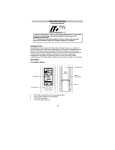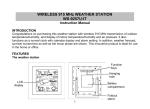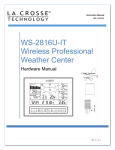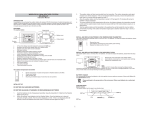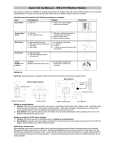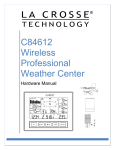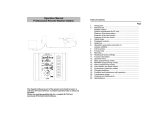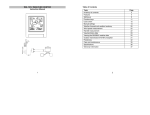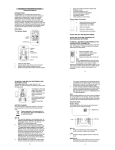Download WIRELESS 868 MHz WEATHER STATION
Transcript
WIRELESS 868 MHz WEATHER STATION Instruction Manual INTRODUCTION Congratulations on purchasing this state-of-the-art weather station as an example of innovative design and quality piece of engineering. Providing time, date, calendar, moon phase, sunrise/sunset time, indoor and outdoor temperature, indoor and outdoor relative humidity, and air pressure history information, this unit will never keep you guessing on current and future weather conditions. Operation of this product is simple and straightforward. By reading this operating manual, the user will receive a better understanding of the weather station together with the optimum benefit of all its features. FEATURES The weather station Function Keys Hanging hole Battery compartment cover LCD Display Foldout stand 24 hour time display (seconds displayed by pressing the SUN key) Weekday, day and month display (year in setting mode) Daylight saving time (DST) function selectable Daily alarm function Weather forecast with weather tendency indicator Temperature display in degree Celsius (°C) Indoor temperature display with MIN/MAX recordings Outdoor temperature display with MIN/MAX recordings, time and date All MIN/MAX temperature recordings can be reset Indoor and outdoor relative humidity display in RH% Display of relative or absolute air pressure in hPa Relative air pressure with adjustable reference value 20 Relative air pressure history bar graph for the past 12 hours Display of sunrise time, sunset time and sun duration in 150 European cities Display 8 moon phase icons with indicator throughout the year LCD contrast setting Indoor and outdoor low battery indicators Table standing/wall mounting Thermo-hygro Transmitter Remote transmission of outdoor temperature and humidity to weather station by 868MHz Wall mounting case Mounting at a sheltered place. Avoid direct rain and sunshine HOW TO INSTALL AND REPLACE BATTERIES IN THE THERMO-HYGRO TRANSMITTER The outdoor thermo-hygro transmitter uses 2 x AAA, IEC LR3, 1.5V batteries. When the batteries need to be replaced, the low battery symbol will appear on the LCD. To install and replace the batteries, please follow the steps below: 1. Remove the cover. 2. Insert batteries, observing the correct polarity (see marking). 3. Replace the battery cover on the unit. HOW TO INSTALL AND REPLACE BATTERIES IN THE WEATHER STATION The weather station uses 2 x C, IEC LR14, 1.5V batteries. To install and replace the batteries, please follow the steps below: 1. Remove the cover at the back of the weather station. 2. Insert batteries, observing the correct polarity (see marking). 3. Replace the compartment cover. Note: Always wait for 2 minutes after removing the batteries before reinserting, otherwise start up and transmission problems may occur. In the event of changing batteries in any of the units, all units need to be reset by following the setting up procedures. 21 BATTERY CHANGE It is recommended to replace the batteries in all units regularly to ensure optimum accuracy of these units (Battery life See Specifications below). Please participate in the preservation of the environment. Return used batteries to an authorized depot. SETTING UP Note: This weather station receives only one outdoor transmitter. 1. 2. 3. 4. First, insert the batteries in the transmitter (see “How to install and replace batteries in the thermohygro transmitter” above). Within 30 seconds of powering up the transmitter, insert batteries in the weather station (see “How to install and replace batteries in the weather station” above). Once the batteries are in place, all segments of the LCD will light up briefly and a short signal tone will sound. Then the indoor temperature, humidity and the time as 0:00 will be displayed. If these information are not displayed on the LCD after 60 seconds, remove the batteries and wait for at least 60 seconds before reinserting them. Once the indoor data is displayed user may proceed to the next step. After the batteries are inserted, the weather station will start receiving data signal from the transmitter. The outdoor temperature and humidity data should then be displayed on the weather station. If this does not happen after 2 minutes, the batteries will need to be removed from both units and reset from step 1. In order to ensure successful 868 MHz transmission, the distance between the weather station and the transmitter should be within 100 meters (see notes on “Positioning” and “868 MHz Reception”). FUNCTION KEYS Weather station: The weather station has five easy to use function keys: SUN key SET key + key ALARM key MIN/MAX key SET key Press and hold for 3 seconds to enter manual setting modes: LCD contrast, Daylight Saving Time ON/OFF, manual time, calendar and relative air pressure reference value To stop the alarm sound 22 To exit alarm setting mode and country/city setting mode To toggle between relative and absolute air pressure display + key To increase/change values in setting modes To stop the alarm sound MIN/MAX key To switch among the display of MIN/MAX indoor temperature and MIN/MAX outdoor temperature records To decrease/change values in setting modes At normal mode, press and hold the key for 3 seconds to reset ALL indoor/outdoor MAX/MIN temperature recordings to current readings To stop the alarm sound ALARM key To activate/deactivate the alarm and display alarm time Press and hold for 3 seconds to enter the alarm setting mode To stop the alarm sound To exit manual setting mode and country/city setting mode SUN key To switch among the display of date (normal mode), seconds, sun duration and city Press and hold for 3 seconds to enter country/city setting mode To stop the alarm sound To exit manual setting mode and alarm setting mode 23 LCD SCREEN The LCD screen is split into 3 sections displaying the information for time/calendar, indoor temperature/humidity, moon phase, sunrise/sunset time, weather forecast, air pressure, and outdoor temperature/humidity. Weekday Summer time indicator Alarm icon Time Indoor Temperature in °C Indoor humidity display in RH% Moon phase indicator Sunrise Time Calendar Sunset Time Weather forecast icon Air pressure history bar graph Weather Tendency indicator Air pressure in hPa (relative or absolute) Low battery indicator (Weather Station) Low battery indicator (Outdoor transmitter) Outdoor Temperature in °C Outdoor data signal reception indicator * MIN/MAX outdoor temperature records Outdoor humidity display in RH% * When the signal is successfully received by the weather station, the outdoor reception icon will be switched on. (If not successful, the icon will not be shown in LCD) So the user can easily see whether the last reception was successful (icon on) or not (icon off). On the other hand, the flashing of the icon shows that a reception is being done now. MANUAL SETTINGS The following settings can be changed when pressing the SET key: LCD contrast Daylight saving time (DST) ON/OFF Manual time Calendar Relative air pressure reference value Press and hold the SET key for about 3 seconds to advance to the setting mode: 24 LCD CONTRAST SETTING Digit flashing The LCD contrast can be set within 8 levels, from LCD 0 to LCD 7 (Default is LCD 3): 1. The digit starts flashing 2. Press the + key or MIN/MAX key to set the level of contrast desired. 3. Press the SET key to enter “Daylight Saving Time On/Off setting,” or exit the setting mode by pressing the ALARM key or SUN key. DAYLIGHT SAVING TIME ON/OFF SETTING Flashing The daylight saving time (DST) function can be set ON/OFF. Default setting is “ON”: 1. “ON” will flash on the LCD with "dSt" displayed. 2. Use the + key to turn the daylight saving time function ON or OFF. 3. Press the SET key to enter “Manual Time setting” or exit the setting mode by pressing the ALARM key or SUN key. MANUAL TIME SETTING Hour (flashing) Minutes To set the clock: 1. The hour digit will start flashing. 2. Use the + key to increase or MIN/MAX key to decrease the value. Keep holding the key allows the value to advance faster. 3. Press the SET key to enter minute setting. 4. The minute will be flashing. Use the + key to increase or MIN/MAX key to decrease the value. 5. Press the SET key to enter “Calendar Setting” or exit the setting mode by pressing the ALARM key or SUN key. CALENDAR SETTING Weekday Year (flashing) Day. Month. 25 1. 2. 3. 4. 5. 6. 7. The year digits will start flashing. Use the + key to increase or MIN/MAX key to decrease the value. The range runs from 2011 to 2025. Press the SET key to enter the month setting mode. The month digit will be flashing. Use the + key to increase or MIN/MAX key to decrease the value. Press the SET key to enter day setting, or exit the setting mode by pressing the ALARM key or SUN key. The day digit will be flashing. Use the + key to increase or MIN/MAX key to decrease the value. Keep holding the key allows the value to advance faster. Press the SET key to enter the “Relative Air Pressure Reference Value Setting”, or exit the setting mode by pressing the ALARM key or SUN key. Note: The corresponding weekday is displayed above the time in short form (from Monday to Sunday): MO / TU / WE / TH / FR / SA / SU RELATIVE AIR PRESSURE REFERENCE VALUE SETTING The default relative pressure value is 1013 hPa (29.92 inHg). This can be manually set to another value within the range of 960 – 1040 hPa (28.35 – 30.72 inHg) for a better reference. flashing 1. 2. 3. The current relative pressure value will start flashing Use the + key or MIN/MAX key to increase or decrease the value. Keep holding the key will allow the value to change faster. Press the SET key to exit the setting mode. LOCATION SETTNG FOR SUNRISE/SUNSET TIME The weather station will automatically update the sunrise, sunset and sun duration time at 00:00, based on the city location, the date, time and DST settings. 1. Press and hold the SUN key for 3 seconds to enter the Location setting mode. 2. The short form of Country name will start flashing. Use the + key or MIN/MAX key to select the Country. Country Code (flashing) Note: 150 European cities can be chosen from. Every country/city is displayed in short code. See the list at the beginning of this handbook for all the country/ city codes. 26 3. 4. With the desired country selected, press the SUN key to enter City setting mode. The City code will start flashing. Use the + key or MIN/MAX key to select the City. Keep holding the key allows the value to advance faster. City Code (flashing) 5. 6. Confirm with the SUN key, or exit the setting mode by pressing the SET key or ALARM key without saving the changes. The city’s sunrise, sun duration and sunset time will be displayed in a few seconds. Sunset icon Sunrise icon Sunrise time 7. Sun duration (hours : minutes) Sunset time Press the SUN key twice to go back to normal date display. DISPLAY OF SUN DURATION TIME 1. 2. 3. In normal date mode, press the SUN key twice to display the sun duration time (total number of hours of sunlight on the day). Press the SUN key again will display the City selected. (See “LOCATION SETTNG FOR SUNRISE/SUNSET TIME”) Press the SUN key again to go back to normal date display. ALARM SETTING To set the daily alarm: 1. Press and hold ALARM key for 3 seconds until the alarm time shown. Alarm time (flashing) 2. 3. 4. Alarm On indicator The hour digit will be flashing. Press the + key or MIN/MAX key to adjust the hour. Press ALARM key once and minute digit will be flashing. Press + key or MIN/MAX key to set the minute, or exit the setting mode by pressing the SET key or SUN key. Press ALARM key once more to return to normal display. Note: To activate/deactivate the alarm function, press the ALARM key shortly. The display of the ((())) icon represents that the alarm is "ON". 27 Note: The duration of alarm sounding is 2 minutes. Press any key will stop the alarm sound. TO EXIT SETTING MODES To exit the setting modes anytime, user can wait for automatic timeout to return to normal display. WEATHER FORECASTING ICONS Weather icons can be displayed in any of the following combinations: Sun Cloud with rain Sun with cloud For every sudden or significant change in the air pressure, the weather icons will update accordingly to represent the change in weather. If the icons do not change, then it means either the air pressure has not changed or the change has been too slow for the Weather station to register. However, if the icon displayed is a sun or raining cloud, there will be no change of icon if the weather gets any better (with sunny icon) or worse (with rainy icon) since the icons are already at their extremes. The icons displayed forecasts the weather in terms of getting better or worse and not necessarily sunny or rainy as each icon indicates. For example, if the current weather is cloudy and the rainy icon is displayed, it does not mean that the product is faulty because it is not raining. It simply means that the air pressure has dropped and the weather is expected to get worse but not necessarily rainy. Note: After setting up, readings for weather forecasts should be disregarded for the next 12-24 hours. This will allow sufficient time for the weather station to collect air pressure data at a constant altitude and therefore result in a more accurate forecast. Common to weather forecasting, absolute accuracy cannot be guaranteed. The weather forecasting feature is estimated to have an accuracy level of about 75% due to the varying areas the weather station has been designed for use. In areas that experience sudden changes in weather (for example from sunny to rain), the weather station will be more accurate compared to use in areas where the weather is stagnant most of the time (for example mostly sunny). If the weather station is moved to another location significantly higher or lower than its initial standing point (for example from the ground floor to the upper floors of a house), discard the weather forecast for the next 12-24 hours. By doing this, the weather station will not mistake the new location as being a possible change in air-pressure when really it is due to the slight change of altitude. WEATHER TENDENCY INDICATOR Working together with the weather icons is the weather tendency indicator (located on the left of the weather icons). When the arrow points upwards, it means that the air pressure is increasing and the weather is expected to improve, but when arrow points downwards, the air pressure is dropping and the weather is expected to become worse. Taking this into account, one can see how the weather has changed and is expected to change. For example, if the indicator is pointing downwards together with cloud and sun icons, then the last noticeable 28 change in the weather was when it was sunny (the sun icon only). Therefore, the next change in the weather will be cloud with rain icons since the indicator is pointing downwards. Note: Once the weather tendency indicator has registered a change in air pressure, it will remain permanently visualized on the LCD. AIR PRESSURE HISTORY (ELECTRONIC BAROMETER WITH BAROMETRIC PRESSURE TREND) The right side of the second section of the LCD shows the air pressure history bar graph. Air pressure trend over the last 12 hours The bar graph indicates the air pressure history trend over the last 12 hours in 5 intervals: 0h, -3h, -6h, -9h and -12h. The “0h” represents the current full hour air pressure recording. The columns represent the “hPa” (0, ±1, ±3, ±5) at specific time. The “0” in the middle of this scale is equal to the current pressure and each change (±1, ±3, ±5) represents how high or low in “hPa“ the past pressure was compared to the current pressure. If the bars are rising it means that the weather is getting better due to the increase of air pressure. If the bars go down, it means the air pressure has dropped and the weather is expected to get worse from the present time “0h“. Note: For accurate barometric pressure trends, the weather station should operate at the same altitude for recordings (i.e. it should not be moved from the ground to the second floor of the house). When the unit is moved to a new location, discard readings for the next 12 hours. ABSOLUTE/RELATIVE AIR PRESSURE Press the SET key to toggle between relative (“rel”) and absolute (“abs”) air pressure displays. Absolute air pressure display Note: Absolute air pressure provides the display of the true measured air pressure of the current time and location. This is not programmable and the absolute air pressure range of the weather station is from 300 hPa to 1099 hPa (standard air pressure at an altitude of 9,100 meters is around 300 hPa). Relative air pressure is the one value that is calculated back to sea level from the local absolute air pressure and can thus be taken as a reference for weather condition and weather development for the entire country. It can be programmed to represent your local surroundings. Since the relative air pressure is also the one value given by various newspapers, TV and radio broadcasting stations in their daily weather forecasts for 29 their respective locations, users can set the relative air pressure of the weather station to this value to represent readings in your area (see “Relative Air Pressure Reference Value Setting” above) INDOOR TEMPERATURE/HUMIDITY DATA The indoor temperature and humidity data are automatically updated and displayed on the first section of the LCD. Indoor temperature in ºC Indoor relative humidity in RH% OUTDOOR TEMPERATURE/HUMIDITY DATA The last LCD section shows the outdoor temperature, MIN/MAX temperature records, humidity and the signal reception indicator. Outdoor humidity in RH% Outdoor temperature in C Outdoor reception icon TO VIEW THE MIN/MAX TEMPERATURE DATA Press the MIN/MAX key several times to view the MIN/MAX indoor and outdoor temperature sequentially. Note: the outdoor MIN/MAX temperature records will also display the recorded time and date Recorded time of the outdoor MIN/MAX record Recorded date of the outdoor MIN/MAX record MAX outdoor temperature RESETTING THE MAXIMUM/MINIMUM RECORDS In normal display mode, press and hold the MIN/MAX key for 3 seconds. This will reset ALL minimum and maximum temperature records to current temperatures. 30 THE MOON PHASE ICONS The weather station displays 8 different moon phase icons. The current moon phase is indicated with a bar segment according to the set calendar. A bar segment indicates the current moon phase Waxing Full Waning Last Waning New Waxing First Crescent Quarter Gibbous Moon Gibbous Quarter Crescent Moon LOW BATTERY INDICATORS Low battery indicator will show on the LCD when the batteries of weather station or transmitter require changing. THERMO-HYGRO TRANSMITTER The reception distance of the thermo-hygro transmitter may be affected by the temperature. At cold temperatures the transmitting distance may be decreased. Please bear this in mind when placing the transmitter. Also the batteries may be reduced in power for the thermo-hygro transmitter. 868 MHz RECEPTION The weather station should receive the temperature data within 2 minutes after set-up. If the temperature data is not received 2 minutes after setting up (the outdoor temperature shows “ --.- ”), please check the following points: 1. The distance of the weather station or transmitter should be at least 1.5 to 2 meters away from any interfering sources such as computer monitors or TV sets. 2. Avoid positioning the weather station onto or in the immediate proximity of metal window frames. 3. Using other electrical products such as headphones or speakers operating on the same signal frequency (868 MHz) may prevent correct signal transmission and reception. 4. Neighbors using electrical devices operating on the 868 MHz signal frequency can also cause interference. Note: When the 868 MHz signal is received correctly, do not re-open the battery cover of either the transmitter or weather station, as the batteries may spring free from the contacts and force a false reset. Should this happen accidentally then reset all units (see Setting up above) otherwise transmission problems may occur. The transmission range is about 100 m from the transmitter to the weather station (in open space). However, this depends on the surrounding environment and interference levels. If no reception is possible despite the observation of these factors, all system units have to be reset (see Setting up). POSITIONING THE WEATHER STATION: The weather station provides the option of table standing or wall mounting. Before wall mounting, please check that the outdoor data can be received from the desired locations. 31 To wall mount: 1. Fix a screw (not supplied) into the desired wall, leaving the head extended out by about 5mm. 2. Place the weather station onto the screw, using the hanging hole on the backside. Gently pull the weather station down to lock the screw into place. Foldout table stand: The foldout table stand leg is located on the backside. Pull the stand out from the bottom center edge of the weather station, below the battery compartment. Once the foldout table stand is extended, place the weather station in an appropriate location. POSITIONING THE THERMO-HYGRO TRANSMITTER: Mounting at a sheltered place. Avoid direct rain and sunshine. The thermo-hygro transmitter can be placed onto any flat surface or wall mount using the bracket which doubles as a stand or wall mount base. To wall mount: 1. Secure the bracket onto a desired wall using the screws and plastic anchors. 2. Clip the transmitter onto the bracket. Note: Before permanently fixing the thermo-hygro to the wall base, pace all units in the desired locations to check that the outdoor temperature and humidity readings are receivable. In event that the signal is not received, relocate the thermo-hygro transmitter or the weather station slightly as this may help the signal reception. 32 CARE AND MAINTENANCE: Extreme temperatures, vibration and shock should be avoided as these may cause damage to the unit and give inaccurate forecasts and readings. When cleaning the display and casings, use a soft damp cloth only. Do not use solvents or scouring agents as they may mark the LCD and casings. Do not submerge the unit in water. Immediately remove all low powered batteries to avoid leakage and damage. Replace only with new batteries of the recommended type. Do not make any repair attempts to the unit. Return them to their original point of purchase for repair by a qualified engineer. Opening and tampering with the unit may invalidate their guarantee. Do not expose the units to extreme and sudden temperature changes, this may lead to rapid changes in forecasts and readings and thereby reduce their accuracy. SPECIFICATIONS Temperature measuring range: Indoor : -9.9ºC to +59.9ºC with 0.1ºC resolution 14.2ºF to 139.8ºF with 0.2ºF resolution (“OF.L” displayed if outside this range) Outdoor : -39.9ºC to +59.9ºC with 0.1ºC resolution -39.8ºF to +139.8ºF with 0.2ºF resolution (“OF.L” displayed if outside this range, “--.-” displayed if no transmitter signal) Relative humidity measuring range: Indoor : 20% to 95% with 1% resolution (Display “- -” if temperature is OF.L; display “19%” “ if < 20% and “96%” if > 95%) Outdoor : 1% to 99% with 1% resolution (Display “- -” if outside temperature is OF.L; display 1% if < 1% and 99% if > 99%) Indoor temperature/humidity checking interval : every 16 seconds Outdoor temperature/humidity reception : every 4 seconds Air pressure checking interval : every 1 minute Transmission range : up to 100 meters (open space) Power consumption (Alkaline batteries recommended): Weather station : 2 x C, IEC, LR14, 1.5V Battery life : Approx. 24 months Thermo-hygro transmitter : 2 x AAA, IEC, LR3, 1.5V Battery life : Approx. 12 months Dimensions (L x W x H) Weather station : 188 x 33.7 x 188 mm Thermo-hygro transmitter : 36 x 16 x 102.6 mm 33 LIABILITY DISCLAIMER: The electrical and electronic wastes contain hazardous substances. Disposal of electronic waste in wild country and/or in unauthorized grounds strongly damages the environment. Please contact your local and/or regional authorities to retrieve the addresses of legal dumping grounds with selective collection. All electronic instruments must from now on be recycled. User shall take an active part in the reuse, recycling and recovery of the electrical and electronic waste. The unrestricted disposal of electronic waste may do harm on public health and the quality of environment. As stated on the gift box and labeled on the product, reading the “User manual” is highly recommended for the benefit of the user. This product must however not be thrown in general rubbish collection points. The manufacturer and supplier cannot accept any responsibility for any incorrect readings and any consequences that occur should an inaccurate reading take place. This product is designed for use in the home only as indication of the temperature. This product is not to be used for medical purposes or for public information. The specifications of this product may change without prior notice. This product is not a toy. Keep out of the reach of children. No part of this manual may be reproduced without written authorization of the manufacturer. R&TTE Directive 1999/5/EC Summary of the Declaration of Conformity: We hereby declare that this wireless transmission device does comply with the essential requirements of R&TTE Directive 1999/5/EC. 34















